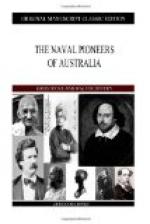The exploring cruise in a whale-boat had lasted from December 3rd, 1797, to February 25th, 1798, and we have before us a log kept by Bass of the voyage. Bass describes in detail all that Hunter tells in his despatch, but the intrepid explorer scarcely mentions the hardships and dangers with which he met. Incidentally he tells how the boat leaked, what heavy seas were often successfully encountered, and how “we collected and salted for food on our homeward voyage stormy petrels” and like luxuries.
Flinders meanwhile, as Hunter says in his despatch, had been sent in the colonial schooner Francis to bring back the castaways [Sidenote: 1799] from the Sydney Cove, who remained anxiously waiting for succour on Preservation Island. On the way down the young lieutenant discovered and named many islands and headlands—the Kent group, the Furneaux group, and Green Cape are only a few names, to wit—and he came back fully convinced that the set of the tide west “indicated a deep inlet or passage through the Indian Ocean.” He had no time on this trip to make surveys, but on his return to Sydney he found that George Bass had just come in in his whale-boat with his report. Hunter and the two young men agreed that the existence of the strait was certain, and that the next thing to do was to sail through it.
The colonial sloop Norfolk, built at Norfolk Island, a few months before, to carry despatches, was selected for the service. She was very small, only 25 tons burden. Flinders was given the command, and Bass was sent with him. The sloop was accompanied by a snow called the Nautilus, which was bound to the Furneaux group on a sealing expedition. The voyage lasted from October 7th, 1798, till January 12th, 1799, and in that period the explorers circumnavigated Van Diemen’s Land, making so many discoveries and naming so many places, that a mere mention of them would fill a chapter. At the end of his log, Flinders tells us that on arrival at Port Jackson—
“to the strait which had now been the great object of research, and whose discovery was now completed, Governor Hunter, at my recommendation, gave the name of Bass’ Straits. This was no more than a just tribute to my worthy friend and companion for the extensive dangers and fatigues he had undergone in first entering it in the whale-boat, and to the correct judgment he had formed from various indications of the existence of a wide opening between Van Dieman’s Land and New South Wales.”
Six months later the Norfolk, with Flinders on board, sailed along the north coast, making many discoveries, but missing the important rivers. Then he returned to England in the Reliance. His tried comrade and friend, Bass, had already left the colony when the Norfolk entered Sydney Heads, and his after-adventures and still mysterious fate, so far as can be conjectured, are told in what follows.




